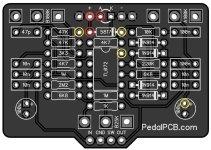Hey guys,
New here, first pedal build and trouble shoot. I am building a blue breaker and by pass works great but when I switch it on i get no output. i made an audio sniffer and i get sound into pin 3 (and none oft he other pins) of the tl072 but no sound coming out. i swapped op amps that i had extra and all 3 same issue. Im unsure about how the ic actually work would the next step be to check negative voltage on pin 2 and or make sure there is good continuity to pcb ground on pin 4? any help would be appreciated. looking forward to being part of the community!
New here, first pedal build and trouble shoot. I am building a blue breaker and by pass works great but when I switch it on i get no output. i made an audio sniffer and i get sound into pin 3 (and none oft he other pins) of the tl072 but no sound coming out. i swapped op amps that i had extra and all 3 same issue. Im unsure about how the ic actually work would the next step be to check negative voltage on pin 2 and or make sure there is good continuity to pcb ground on pin 4? any help would be appreciated. looking forward to being part of the community!






